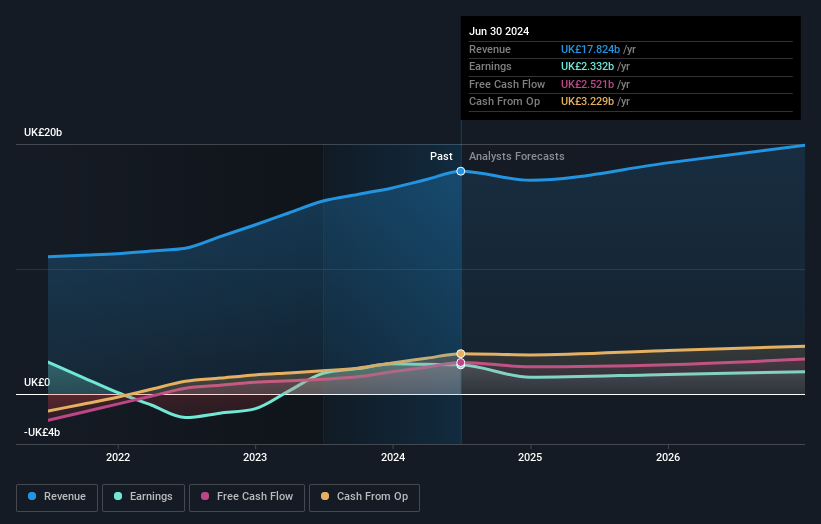- United Kingdom
- /
- Aerospace & Defense
- /
- LSE:RR.
Institutional investors have a lot riding on Rolls-Royce Holdings plc (LON:RR.) with 76% ownership

Key Insights
- Institutions' substantial holdings in Rolls-Royce Holdings implies that they have significant influence over the company's share price
- The top 24 shareholders own 51% of the company
- Insiders have been buying lately
If you want to know who really controls Rolls-Royce Holdings plc (LON:RR.), then you'll have to look at the makeup of its share registry. And the group that holds the biggest piece of the pie are institutions with 76% ownership. In other words, the group stands to gain the most (or lose the most) from their investment into the company.
And things are looking up for institutional investors after the company gained UK£1.5b in market cap last week. The one-year return on investment is currently 137% and last week's gain would have been more than welcomed.
Let's take a closer look to see what the different types of shareholders can tell us about Rolls-Royce Holdings.
See our latest analysis for Rolls-Royce Holdings

What Does The Institutional Ownership Tell Us About Rolls-Royce Holdings?
Many institutions measure their performance against an index that approximates the local market. So they usually pay more attention to companies that are included in major indices.
Rolls-Royce Holdings already has institutions on the share registry. Indeed, they own a respectable stake in the company. This can indicate that the company has a certain degree of credibility in the investment community. However, it is best to be wary of relying on the supposed validation that comes with institutional investors. They too, get it wrong sometimes. When multiple institutions own a stock, there's always a risk that they are in a 'crowded trade'. When such a trade goes wrong, multiple parties may compete to sell stock fast. This risk is higher in a company without a history of growth. You can see Rolls-Royce Holdings' historic earnings and revenue below, but keep in mind there's always more to the story.

Investors should note that institutions actually own more than half the company, so they can collectively wield significant power. We note that hedge funds don't have a meaningful investment in Rolls-Royce Holdings. Looking at our data, we can see that the largest shareholder is BlackRock, Inc. with 6.9% of shares outstanding. With 6.8% and 4.6% of the shares outstanding respectively, Capital Research and Management Company and The Vanguard Group, Inc. are the second and third largest shareholders.
After doing some more digging, we found that the top 24 have the combined ownership of 51% in the company, suggesting that no single shareholder has significant control over the company.
Researching institutional ownership is a good way to gauge and filter a stock's expected performance. The same can be achieved by studying analyst sentiments. There are plenty of analysts covering the stock, so it might be worth seeing what they are forecasting, too.
Insider Ownership Of Rolls-Royce Holdings
The definition of company insiders can be subjective and does vary between jurisdictions. Our data reflects individual insiders, capturing board members at the very least. Company management run the business, but the CEO will answer to the board, even if he or she is a member of it.
I generally consider insider ownership to be a good thing. However, on some occasions it makes it more difficult for other shareholders to hold the board accountable for decisions.
Our most recent data indicates that insiders own less than 1% of Rolls-Royce Holdings plc. As it is a large company, we'd only expect insiders to own a small percentage of it. But it's worth noting that they own UK£8.0m worth of shares. It is always good to see at least some insider ownership, but it might be worth checking if those insiders have been selling.
General Public Ownership
The general public, who are usually individual investors, hold a 22% stake in Rolls-Royce Holdings. While this size of ownership may not be enough to sway a policy decision in their favour, they can still make a collective impact on company policies.
Next Steps:
It's always worth thinking about the different groups who own shares in a company. But to understand Rolls-Royce Holdings better, we need to consider many other factors. Be aware that Rolls-Royce Holdings is showing 3 warning signs in our investment analysis , and 2 of those can't be ignored...
Ultimately the future is most important. You can access this free report on analyst forecasts for the company.
NB: Figures in this article are calculated using data from the last twelve months, which refer to the 12-month period ending on the last date of the month the financial statement is dated. This may not be consistent with full year annual report figures.
New: AI Stock Screener & Alerts
Our new AI Stock Screener scans the market every day to uncover opportunities.
• Dividend Powerhouses (3%+ Yield)
• Undervalued Small Caps with Insider Buying
• High growth Tech and AI Companies
Or build your own from over 50 metrics.
Have feedback on this article? Concerned about the content? Get in touch with us directly. Alternatively, email editorial-team (at) simplywallst.com.
This article by Simply Wall St is general in nature. We provide commentary based on historical data and analyst forecasts only using an unbiased methodology and our articles are not intended to be financial advice. It does not constitute a recommendation to buy or sell any stock, and does not take account of your objectives, or your financial situation. We aim to bring you long-term focused analysis driven by fundamental data. Note that our analysis may not factor in the latest price-sensitive company announcements or qualitative material. Simply Wall St has no position in any stocks mentioned.
About LSE:RR.
Rolls-Royce Holdings
Develops and delivers complex power and propulsion solutions for air, sea, and land in the United Kingdom and internationally.
Good value with proven track record.
Similar Companies
Market Insights
Community Narratives



